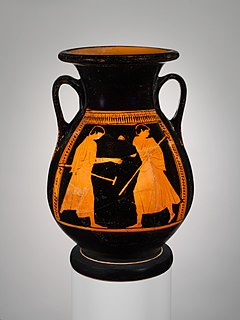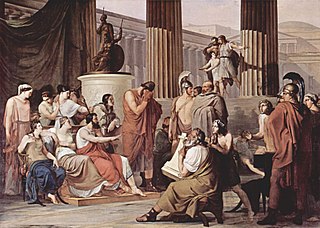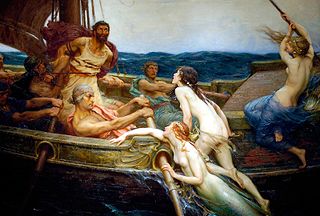 W
WOdysseus, also known by the Latin variant Ulysses, is a legendary Greek king of Ithaca and the hero of Homer's epic poem the Odyssey. Odysseus also plays a key role in Homer's Iliad and other works in that same epic cycle.
 W
WCyclops is an ancient Greek satyr play by Euripides, based closely on an episode from the Odyssey. It would have been the fourth part of a tetralogy presented by Euripides in a dramatic festival in 5th Century BC Athens. The date of its composition is unknown, but it was probably written late in Euripides' career. It is the only complete and extant satyr play.
 W
WA pelike was a ceramic container that the Greeks used as storage/transportation for wine and olive oil. As seen in the picture on the right, it had a large belly with thin, open handles. Unlike other transportation jars, a pelike would have a flattened bottom so that it could stand on its own. Pelikes often had one large scene across the belly of the jar with minimal distractions around. This would focus the viewers eyes to the center of the pelike which was often a mythological scene of sorts.
 W
WOdysseus at the Court of Alcinous is an oil on canvas painting by Francesco Hayez, painted between 1814 and 1816 and now in the National Museum of Capodimonte in Naples. It was commissioned for Gioacchino Murat by Naples' interior minister Giuseppe Zurlo, using dimensions, price and subject specified by Hayez's patron and protector Leopoldo Cicognara, president of the Accademia di Venezia.
 W
WPhiloctetes is a play by Sophocles. The play was written during the Peloponnesian War. It is one of the seven extant tragedies by Sophocles. It was first performed at the City Dionysia in 409 BC, where it won first prize. The story takes place during the Trojan War. It describes the attempt by Neoptolemus and Odysseus to bring the disabled Philoctetes, the master archer, back to Troy from the island of Lemnos.
 W
WThe Sirens and Ulysses is a large oil painting on canvas by the English artist William Etty, first exhibited in 1837. It depicts the scene from Homer's Odyssey in which Ulysses (Odysseus) resists the bewitching song of the Sirens by having his ship's crew tie him up, while they are ordered to block their own ears to prevent themselves from hearing the song.
 W
WUlysses and the Sirens is a 1909 oil painting by Herbert James Draper measuring 69.25 × 84 in. It is held at the Ferens Art Gallery in Kingston upon Hull, England. The gallery purchased the painting from Draper in 1910 for £600. Draper also painted a reduced replica that is housed at the Leeds Art Gallery. The subject of the painting is an episode in the epic poem Odyssey by Homer in which Ulysses is tormented by the voices of Sirens, although there are only two Sirens in Homer's poem and they stay in a meadow. The painting depicts Ulysses tied to the mast and forcibly attendant to the Sirens' seductions. Although the Sirens were depicted in ancient Greek art as scary, ugly creatures, Draper maintains the spirit but not the content of the story by transferring the Sirens' seductiveness from their song to a visible form, depicting the Sirens as beautiful mermaids who invade Ulysses' ship. The Sirens are nude and their tails disappear as they board the ship. Draper's conflation of Sirens with mermaids and his sexualization of these figures are consistent with other artwork of the Victorian and Edwardian eras. Norwegian social theorist Jon Elster used the name of Draper's painting as the title for his 1979 book about rationality and precommitment.
 W
WUlysses and the Sirens is an 1891 painting by Pre-Raphaelite artist John William Waterhouse. It is currently held in the National Gallery of Victoria, Melbourne, Australia.